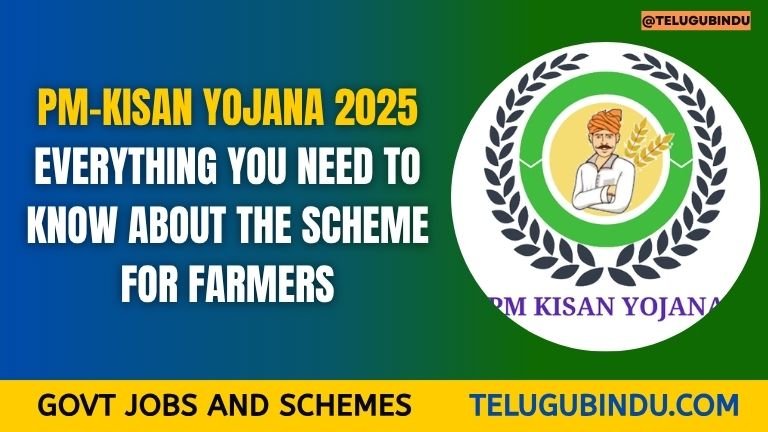PM-Kisan Yojana 2025: Everything You Need to Know About the Scheme for Farmers
The Pradhan Mantri Kisan Samman Nidhi (PM-KISAN) scheme, popularly known as PM Kisan Yojana, is one of the most significant welfare programs launched by the Government of India to support small and marginal farmers. Introduced in 2019, this scheme provides direct income support to eligible farmers across the country to help them manage agricultural and household expenses.
With the 2025 budget focusing on rural welfare and agricultural development, the PM-KISAN Yojana continues to be a major source of support for millions of farmers. Here’s a detailed look at the scheme, its benefits, eligibility, and how to apply or check payment status.
🔍 Overview of PM-Kisan Yojana
-
Name of the Scheme: Pradhan Mantri Kisan Samman Nidhi (PM-KISAN)
-
Launched by: Government of India
-
Launch Year: February 2019
-
Beneficiaries: Small and marginal farmers
-
Financial Benefit: ₹6,000 per year
-
Payment Mode: Direct Bank Transfer (DBT) in three installments
💰 What Are the Benefits of the PM-Kisan Scheme?
Under PM-KISAN, eligible farmers receive ₹6,000 every year, paid in three equal installments of ₹2,000 each. These are generally distributed in the following months:
-
First Installment: April – July
-
Second Installment: August – November
-
Third Installment: December – March
This financial assistance is aimed at easing the financial burden of farmers and helping them with inputs like seeds, fertilizers, labor, and irrigation.
✅ Eligibility Criteria
To receive benefits under PM-KISAN, a farmer must meet the following criteria:
-
Should be an Indian citizen.
-
Must own cultivable agricultural land.
-
The land should be in the farmer’s name as per land records.
-
Institutional landholders and higher-income category taxpayers are not eligible.
❌ Who Are Not Eligible?
-
Former and current constitutional post holders.
-
Former and current ministers, MPs, and MLAs.
-
Government employees (including retired) drawing pensions above a certain threshold.
-
Income tax payers in the previous assessment year.
-
Professionals like doctors, engineers, lawyers, and chartered accountants registered with professional bodies.
📝 How to Apply for PM-KISAN Scheme
If you’re a farmer and haven’t registered yet, you can follow these steps:
-
Visit the official website: https://pmkisan.gov.in
-
Click on “New Farmer Registration”.
-
Enter your Aadhaar number, mobile number, and bank details.
-
Upload necessary documents like land records and ID proof.
-
Submit the application.
Alternatively, farmers can apply through Common Service Centers (CSCs) in their villages.
🔍 How to Check PM-KISAN Payment Status
-
Go to https://pmkisan.gov.in
-
Click on “Beneficiary Status” under the “Farmers Corner”.
-
Enter your Aadhaar number or Account number.
-
Click on Get Data to see the status of your payment.
📆 Latest Update – 16th Installment
As of 2025, the government is preparing to release the 16th installment of the PM-KISAN scheme. Eligible farmers are advised to:
-
Ensure their Aadhaar is linked to their bank account.
-
Complete the eKYC process online or at CSCs.
-
Check their land records for accuracy.
Failure to complete eKYC may result in payment delays or rejection of the installment.
💬 State-wise Implementation
Though PM-KISAN is a centrally sponsored scheme, states are responsible for verifying landholding details and beneficiary eligibility. States like Maharashtra, Uttar Pradesh, Karnataka, Andhra Pradesh, and Telangana have a high number of beneficiaries.
📈 Impact of the Scheme
Since its launch, PM-KISAN has benefitted over 11 crore farmers. The scheme has:
-
Reduced dependence on local moneylenders.
-
Helped improve productivity.
-
Increased financial stability for small farmers.
The total amount transferred under the scheme has crossed ₹2.5 lakh crores as of 2025.
☎️ Helpline Numbers
-
PM-KISAN Helpline: 155261 / 011-24300606
-
Email Support: pmkisan-ict@gov.in
📝 Final Words
The PM-KISAN scheme is a lifeline for millions of small farmers in India. As agriculture remains the backbone of the Indian economy, such welfare initiatives are critical in ensuring food security, reducing poverty, and improving rural livelihoods. If you’re a farmer, make sure your details are updated and verified to continue receiving this financial support.
